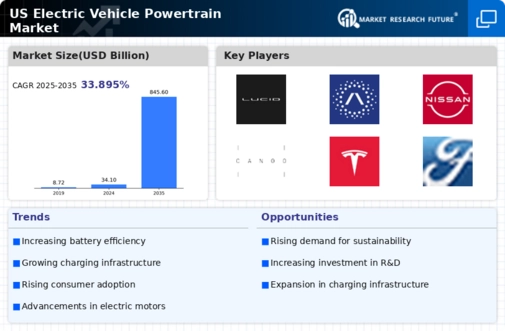Advancements in Charging Technology
The electric vehicle-powertrain market is significantly influenced by advancements in charging technology, which enhance the convenience and accessibility of electric vehicles. Innovations such as fast-charging stations and wireless charging systems are becoming increasingly prevalent in the US. For instance, the deployment of ultra-fast charging stations has expanded, allowing EVs to recharge in as little as 15 minutes. This development not only alleviates range anxiety among consumers but also encourages the adoption of electric vehicles. The electric vehicle-powertrain market is thus poised for growth as charging infrastructure becomes more robust and user-friendly. Additionally, the integration of smart charging solutions, which optimize energy use and reduce costs, further supports the market's expansion. As charging technology continues to evolve, it is expected to play a crucial role in shaping consumer perceptions and driving the adoption of electric vehicles.
Corporate Sustainability Initiatives
The electric vehicle-powertrain market is increasingly shaped by corporate sustainability initiatives, as businesses recognize the importance of reducing their carbon footprints. Many companies in the US are committing to electrifying their fleets, which directly impacts the demand for electric powertrains. For example, major corporations have pledged to transition to 100% electric fleets by 2030, creating a substantial market for electric vehicle powertrains. This trend not only supports the electric vehicle-powertrain market but also aligns with consumer expectations for environmentally responsible practices. Furthermore, as businesses adopt electric vehicles, they often seek partnerships with powertrain manufacturers to develop tailored solutions that meet their operational needs. This collaboration fosters innovation and drives advancements in powertrain technology, ultimately benefiting the entire electric vehicle-powertrain market.
Investment in Renewable Energy Sources
The electric vehicle-powertrain market is positively impacted by the increasing investment in renewable energy sources, which supports the sustainability of electric vehicles. As the US transitions towards cleaner energy, the integration of renewable energy into the grid enhances the environmental benefits of electric vehicles. For instance, solar and wind energy are becoming more prevalent, allowing EVs to be charged with clean power. This shift not only reduces the overall carbon emissions associated with electric vehicle usage but also strengthens the electric vehicle-powertrain market by promoting the adoption of electric vehicles. Additionally, as more consumers become aware of the environmental advantages of using renewable energy for charging, the demand for electric vehicles is likely to rise. This synergy between renewable energy and electric vehicle powertrains creates a favorable environment for market growth.
Rising Consumer Demand for Electric Vehicles
The electric vehicle-powertrain market experiences a notable surge in consumer demand, driven by increasing environmental awareness and the desire for sustainable transportation solutions. In the US, sales of electric vehicles (EVs) have risen dramatically, with a reported increase of over 70% in 2023 alone. This growing interest in EVs propels the demand for advanced powertrain technologies, as consumers seek vehicles that offer enhanced performance, efficiency, and lower emissions. The electric vehicle-powertrain market is thus positioned to benefit from this trend, as manufacturers invest in innovative powertrain solutions to meet consumer expectations. Furthermore, the shift towards electric mobility aligns with broader societal goals of reducing carbon footprints, which further fuels market growth. As consumers become more educated about the benefits of EVs, the electric vehicle-powertrain market is likely to see sustained demand in the coming years.
Technological Integration and Smart Features
The electric vehicle-powertrain market is increasingly influenced by the integration of advanced technologies and smart features in electric vehicles. Innovations such as vehicle-to-grid (V2G) technology and advanced driver-assistance systems (ADAS) are becoming more common, enhancing the overall driving experience. In the US, the incorporation of these technologies not only improves vehicle performance but also contributes to energy efficiency. For example, V2G technology allows electric vehicles to return energy to the grid, creating a more sustainable energy ecosystem. This trend encourages consumers to consider electric vehicles, thereby driving demand in the electric vehicle-powertrain market. Furthermore, as manufacturers continue to invest in research and development, the introduction of new smart features is expected to further differentiate electric vehicles in a competitive market, potentially leading to increased sales and market penetration.


























Leave a Comment